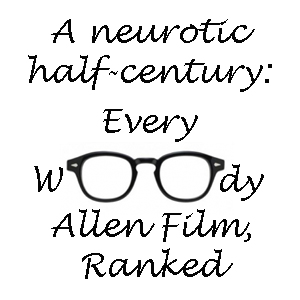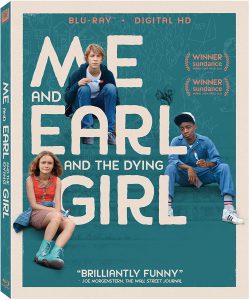“Me and Earl and the Dying Girl” (now available from Redbox) follows last year’s “The Fault in Our Stars” into the cancersploitation genre – a coming-of-age story with one or more terminal teenagers thrown in. The notable difference is that while “Fault” (which I liked a lot) plays up the melodrama, “Me and Earl” is much more grounded. Neither is based on a true story, but the whole time I watched “Me and Earl,” I felt like it was.
That sounds like a compliment, but it was more of an excuse I was making for the film, adapted by Jesse Andrews from his own YA novel and directed by Alfonso Gomez-Rejon. “Me and Earl” starts slowly and never made me sit up and take notice. It’s not exactly boring, as it features believable characters, big-name supporting actors (Connie Britton, Nick Offerman, Molly Shannon and “The Walking Dead’s” Jon Bernthal) and a foundation of quirkiness. Greg (Thomas Mann) and Earl (RJ Cyler) make bad short films based on puns from classic titles (for example, “A Sockwork Orange,” with sock puppets), while cancer-stricken Rachel (Olivia Cooke, who, in an odd bit of typecasting, also plays a dying girl in “Bates Motel”) covers her bedroom wall with scissors.
Admittedly, “Me and Earl” is giving me more to think about it as I write this review the next day. But it’s not a great movie while you’re watching it. I suppose it should get credit for not blatantly jerking tears the way “Fault” does, but I think it goes too far in the opposite direction, ending up far too understated.
I’m drawn to coming-of-age films (I’m looking forward to “Paper Towns” hitting Redbox later this month), and that’s why “Me and Earl” made my viewing list. I like to see how the genre changes with time. I have a pet theory that teenagers – while still self-centered – have gradually become nicer in the past few decades, so the old concept of awkward kids being mercilessly picked on has become outdated. Greg is one of those self-centered but nice kids whose strategy for surviving his Pittsburgh high school is simple: Have good but casual relationships with all cliques, but make friends with no one. Remain invisible. (This isn’t hard to do, as high school kids are notoriously focused on their own lives. Indeed, some teenage stories, notably the “Buffy” episode “Out of Mind, Out of Sight,” are about teens who hate going unnoticed by their classmates.)
In the movie’s most smile-worthy scene – depicted on the poster where the trio is eating popsicles — Earl tells Rachel about his friendship with Greg. Rachel asks why Greg refers to them as “co-workers.” Earl explains: “Naw, we friends. He just hates calling people his friend. Dude’s got issues.”
For more analysis for those who have already seen the movie, SPOILERS start now.
In Rachel’s letter to Greg that closes the film, she notes that Greg regularly put a smile on her face with his jokes and silly movies and made the last six months of her life better. The movie doesn’t earn this line, though, because Rachel rarely smiles nor does Greg regularly land zingers. Similar to Shailene Woodley in “Fault,” Cooke is arguably a bit too vibrant and beautiful for this role, but the actress does at least look miserable all the time. The scene where she cries about losing her hair to chemotherapy is well done, as her speech to Greg nicely illustrates to male viewers the importance of hair to a female’s (particularly a teenage girl’s) self-image.

“Me and Earl” feels claustrophobic, as the whole film takes place in Pittsburgh (although I kept thinking Kansas, due to references to “Pitt State”), and Rachel’s scenes are mostly in her bedroom or a hospital room. Whereas “Fault” found Hazel cramming in a ton of life experiences before her death, Rachel withers away. It’s not fun to watch, but it is interesting to reflect on how Greg and Earl provided some lighter moments for her, and it is realistic that the awkward kid and the dying girl stay firmly in the friend zone. At least twice, the film sets up cinematic moments where they should kiss, but Greg’s voiceover reminds us it isn’t that type of story, and they don’t.
Another smart but unsatisfying (in the sense of traditional plotting) thread finds the school’s resident hot girl, Madison (Katherine Hughes), crossing paths with Greg. Every time she puts her hand on his shoulder, we get an aside of an animated moose stomping a guinea pig. Greg finally calls her out, asking if she does the shoulder thing to get guys to do what she wants. Then she asks him to prom, promising that it’s not a pity date. Again, cue the record scratch, because that’s Madison’s last scene; Greg is going to prom, but only figuratively, as he dons a tux to visit Rachel in the hospital in what turns out to be her death scene.
The message of “Me and Earl” is that friendship is important, and that you don’t need to be a teenage Casanova (like “Fault’s” Gus) or have an amazing talent (Greg and Earl’s films, as they warn us, are indeed terrible) to be a good friend. That’s a strong message, sure, but “Me and Earl” needed more.
The film seems to be missing about a dozen important scenes. The friendship between the trio doesn’t exactly ring false, but it’s not particularly vibrant. Greg and Rachel don’t connect over anything specific, so their friendship doesn’t rise from the foundation of Greg’s mom (Britton) instructing him to be a friend to Rachel. Greg doesn’t find out about Rachel’s amazing artistic skills until he examines her bookshelf at her wake. That’s one of many odd choices that made me assume “Me and Earl” was based on a true story, because in a scripted story, wouldn’t Greg and Rachel bond over art while she’s still alive?
“Me and Earl and the Dying Girl” successfully dodges melodrama at every turn, but it does so at the cost of not having enough of a movie left over.

